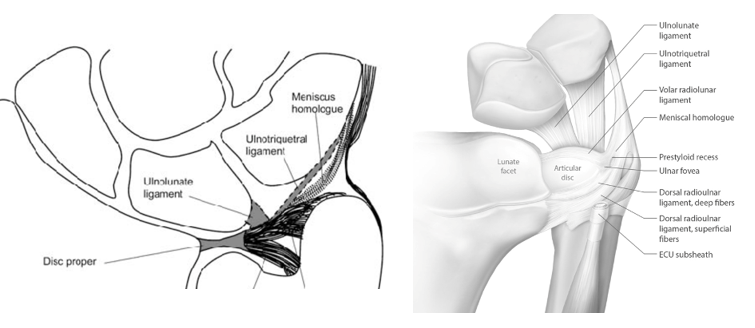Triangular fibrocartilage complex repair (TFCC) tear
What is a Triangular Fibrocartilage Complex (TFCC) Tear?
The Triangular Fibrocartilage Complex (TFCC) is a three-dimensional structure that links the radius and ulnar with the small bones of the wrist. The TFCC provides stability for rotation/twisting of the forearm and acts as a cushion between the ulnar and smaller carpal bones

How do TFCC Tears Occur?
An acute peripheral TFCC tear can occur from a fall, a twisting injury or with a fracture of the wrist. These usually occur in younger patients.
An acute central TFCC tear can occur with repetitive loading or a sudden fall when the TFCC is compressed between the ulnar and the small (carpal) bones of the wrist. This is more likely if the ulnar bone is relatively more prominent (longer) than the radius. It is called ulnocarpal abutment syndrome.
Chronic TFCC tears are a common finding in adults over 40 years as part of normal wear over time and are not a cause of pain.
Signs & Symptoms
Acute tears usually cause pain, particularly with twisting the forearm with a weight in the hand or loading bodyweight through the wrist. A sense of instability, limited wrist movement or painful clicking of the wrist with activity may also occur.
How is a TFCC Tear Diagnosed?
A history consistent with a TFCC tear and specific wrist examination tests and imaging to diagnose TFCC tear. Plain x-rays are helpful in determining if there has been any bone injury and to show if the ulnar is particularly long relative to the radius. If there has been ulnocarpal abutment, small cysts in the ulnar head or lunate may be visible on x-ray. MRI scan is more accurate in diagnosing TFCC tears and the location and extent of these injuries.
How is it Treated?
Many TFCC tears can be treated non-operatively initially. Conservative treatment options may include wrist splints, hand therapy, activity modification, anti-inflammatory medications and/or steroid injection. The more severe injuries with significant pain and instability often require surgical repair or, if longstanding, a reconstruction may be needed.
The most common treatment is repair of the TFFC back to bone using a suture anchor. This is performed under general anaesthetic as a day surgery procedure. The patient is discharged home in a bandage & light-weight forearm splint for 2 weeks.

What is the Recovery?
Full recovery from a TFCC repair is usually 6-12 months. Most people will have returned to all their normal activities with minimal discomfort by 6 months. Normal function is the expected outcome.
2-weeks: Bandages are removed, a removable splint applied by the hand therapist and wrist exercises are commenced. No twisting activities.
6-8 weeks: Twisting/rotating exercises and graduated strengthening commenced.
3-4 months: Most light activities pain-free
6-12 months: Full recovery
What are the Possible Risks?
The most common issues include.
• Wrist/forearm stiffness
• Residual discomfort
• Failure/loosening of the anchor
• Superficial skin nerve injury/irritation
• Infection < 1%

